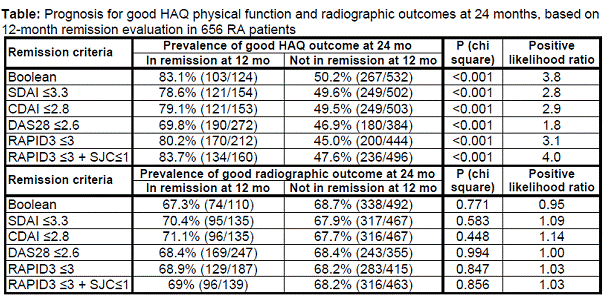Session Information
Session Type: Abstract Submissions (ACR)
Background/Purpose: Different criteria for remission in rheumatoid arthritis (RA) have been developed from a Core Data Set of 7 measures for the DAS28, SDAI, CDAI and RAPID3 (with only patient self-report measures). An ACR/EULAR committee proposed two criteria: “Boolean,” with TJC28, SJC28, CRP, PATGL all ≤1; and SDAI ≤3.3 [Arthritis Rheum 2011;63:573]. A recent report indicated that remission criteria based on RAPID3 ≤3 with ≤1 swollen joint (RAPID3RJ1) gave results similar to Boolean and SDAI criteria, but without a formal joint count to be more feasible for usual care [J Rheumatol 2013;40:386]. This new study analyzed 6 remission criteria to predict a good outcome for physical function and radiographic damage one year later in the ESPOIR cohort of French early arthritis patients.
Methods: ESPOIR includes patients with early arthritis who received routine care. Remission was assessed 12 months after baseline by 6 criteria: ACR/EULAR Boolean criteria; SDAI (≤3.3); CDAI (≤2.8); DAS28 (≤2.6); RAPID3 (≤3) and RAPID3RJ1 (RAPID3 ≤3 and ≤1 swollen joint). Analyses were conducted to determine status 12 months later (at 24 months) to recognize whether a patient who met each remission criteria 12 months earlier was likely or not to have a good functional outcome [stable or lower HAQ scores, and absolute score of ≤0.5 at both 12 and 24 months after baseline] or good radiographic outcome [no change in the modified Sharp/van der Heijde score from 12 to 24 months]. The proportions of good outcomes in patients who had been classified 12 months earlier as in or not in remission were compared by chi square tests and likelihood ratios.
 Results: 656 patients had available data to evaluate remission; 76% were women; mean age 48 years; median baseline disease duration 5 months; 40% ACPA-positive and 44% rheumatoid factor-positive. Patients who were in remission at 12 months according to each of 6 criteria were significantly more likely to have a good functional status outcome 12 months later (24 months after baseline), ranging from 70-84%,versus 45-50% of patients not in remission. Positive likelihood ratios for having a good functional outcome were 3.8 and 4.0 for Boolean and RAPID3RJ1; 2.8-3.1 for RAPID3, CDAI and SDAI; and 1.8 for DAS28 criteria. Patients who were in remission at 12 months according to each of the 6 criteria had a similar 67-71% likelihood to have a good radiographic outcome 12 months later (24 months after baseline), similar to patients who were not in remission (Table). Similar analyses performed in subsets of patients who were RF+ and/or had baseline damage, yielded similar results.
Results: 656 patients had available data to evaluate remission; 76% were women; mean age 48 years; median baseline disease duration 5 months; 40% ACPA-positive and 44% rheumatoid factor-positive. Patients who were in remission at 12 months according to each of 6 criteria were significantly more likely to have a good functional status outcome 12 months later (24 months after baseline), ranging from 70-84%,versus 45-50% of patients not in remission. Positive likelihood ratios for having a good functional outcome were 3.8 and 4.0 for Boolean and RAPID3RJ1; 2.8-3.1 for RAPID3, CDAI and SDAI; and 1.8 for DAS28 criteria. Patients who were in remission at 12 months according to each of the 6 criteria had a similar 67-71% likelihood to have a good radiographic outcome 12 months later (24 months after baseline), similar to patients who were not in remission (Table). Similar analyses performed in subsets of patients who were RF+ and/or had baseline damage, yielded similar results.
Conclusion: A good functional outcome at 24-month follow-up was 1.8-4.0 times more likely in patients who were in remission versus not in remission 12 months after baseline; the highest likelihood ratios were seen for the Boolean and RAPID3RJ1 criteria. Radiographic outcomes at 24 months were similar, regardless of remission status 12 months earlier.
Disclosure:
I. Castrejón,
None;
M. Dougados,
None;
B. Combe,
None;
F. Guillemin,
None;
B. Fautrel,
None;
T. Pincus,
None.
« Back to 2013 ACR/ARHP Annual Meeting
ACR Meeting Abstracts - https://acrabstracts.org/abstract/prognosis-in-espoir-rheumatoid-arthritis-cohort-at-24-months-according-to-remission-status-at-12-months-no-differences-in-radiographic-scores-according-to-prior-remission-status-but-significant-diff/
